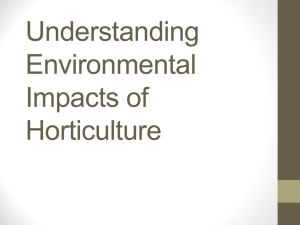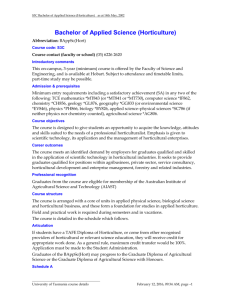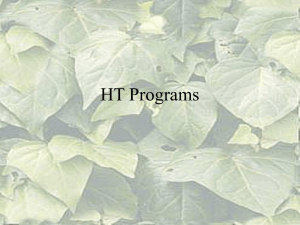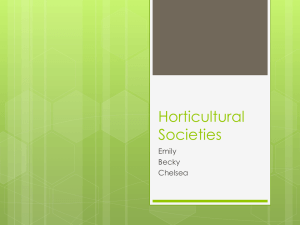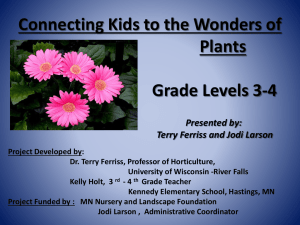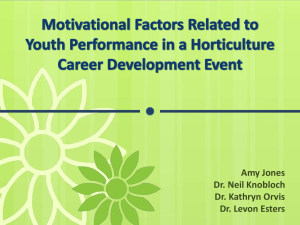Environmental Impacts of Horticulture
advertisement
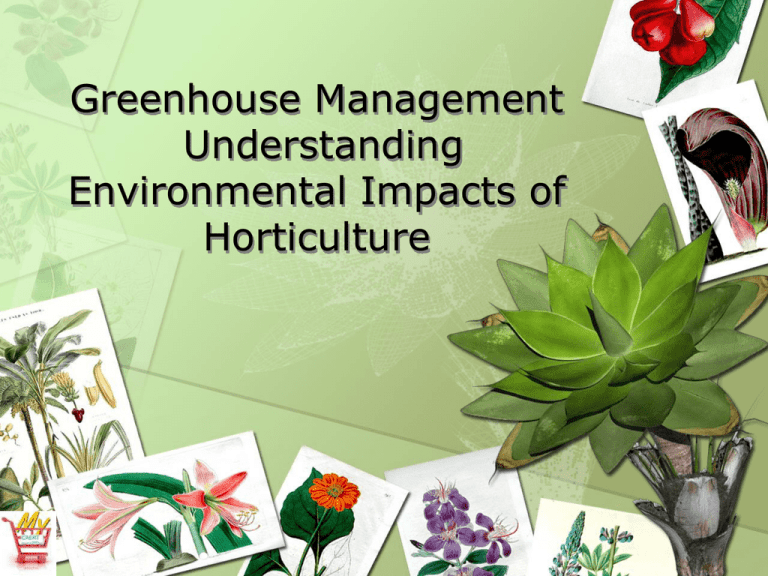
Greenhouse Management Understanding Environmental Impacts of Horticulture Student Learning Objectives •Explain environment and issues related to the environment. •Explain how horticulture is beneficial to the environment. •Explain how horticulture can damage the environment. Student Learning Objectives •Identify how natural resources can be affected by horticultural practices. •Identify how chemicals used in horticulture can affect the environment. What is the environment and what are issues related to the environment? • Horticulture and the environment are intertwined. The environment is the nonliving, or abiotic, aspect of an organism’s immediate habitat. • It includes physical and chemical features, such as rocks, minerals, air, and water. What is the environment and what are issues related to the environment? • Living things, including horticultural plants, animals, and microorganisms, are referred to as biotic. • The study of living things in relation to their environment is called ecology. • An ecosystem is a community of organisms and its nonliving environment. What is the environment and what are issues related to the environment? • One cannot ignore the fact that horticultural practices have an influence on an ecosystem. • Some practices disturb the ecosystem. • However, proper horticultural practices can limit the negative impact on the ecosystem. What is the environment and what are issues related to the environment? • Public demand for a high-quality product, growers concerned over how to produce a high-quality product at a low cost, and the impaired health of the environment have raised issues. • Intensive land use involves using production practices on large fields to get top yields. • These practices can greatly affect the natural resources in an area by altering the natural environment. What is the environment and what are issues related to the environment? • The use of integrated pest management is a biological control method used to fight pests. • Integrated pest management (IPM) limits damage to the environment. • IPM is a strategy that uses a combination of measures to reduce pest damage with the least disruption to the environment. What is the environment and what are issues related to the environment? • Biotechnology and genetic engineering have been used to help produce new plant varieties and improve others. • Some people are concerned with the environmental impact of these genetically altered plants. What is the environment and what are issues related to the environment? • Horticultural practices have introduced new plant species. • Some of these species have escaped cultivation and have out-competed native species, disrupting the ecological balance. • Plants that have the ability to thrive and spread aggressively outside their natural range are called invasive plants. tree-of-heaven Purple loosestrife multiflora rose How is horticulture beneficial to the environment? • Horticulture is beneficial to the environment in many ways. Its benefits can be both personal and biological. • Plants can be used for personal benefit in recreational settings such as golf courses and public parks. How is horticulture beneficial to the environment? • Biological benefits of horticulture include the use of plant parts to help prevent erosion, slow water runoff, absorb pollutants, control dust, and provide wildlife habitat. How is horticulture beneficial to the environment? • Landscaping can also help improve the value of real estate by increasing the beauty of an area. How can horticulture damage the environment? • Many horticultural practices require the disruption of the earth and the application of chemicals. • If not applied as directed, these chemicals can become pollutants. • Pollution is a hazard of horticultural practices. How can horticulture damage the environment? • These practices, and others, can cause harm to the environment if not practiced carefully. • Improper management and excessive or improper use of chemicals or water supplies are examples of ways horticulture can damage the environment. How can horticulture damage the environment? • Pollution occurs when harmful or degrading materials get into the environment. • Point source pollution comes from sources that are easily identified. • An example would be severe soil erosion from a landscape construction site. • This type of pollution is easier to control than nonpoint source pollution. How can horticulture damage the environment? • Nonpoint source pollution can come from few to many different sources and is more difficult to control. • Widespread use of chemical fertilizers and pesticides on lawns in urban areas can lead to pollution of waterways. • This type of pollution cannot be traced to a single place of origin. How can natural resources be affected by horticultural practices? • Water resources, wetlands, and wildlife are all natural resources that can be affected by horticultural practices. • These effects can be adverse or beneficial. • Water resources are essential to the environment, since all living things need water. • When water is used, nature has its way of restoring it. • The hydrologic cycle and infiltration are two ways nature restores water. How can natural resources be affected by horticultural practices? • The hydrologic cycle is the way water flows through the environment from sources such as oceans, lakes, rivers, streams, groundwater, and reservoirs. • Water moves through a series of processes, including: • Precipitation—water deposited on the earth in the form of rain or snow How can natural resources be affected by horticultural practices? • Evaporation—the changing of water from a liquid to a vapor while passing through the air • Transpiration—the movement of water in vapor form • Condensation—the changing of water from a vapor to a liquid How can natural resources be affected by horticultural practices? THE HYDROLOGIC CYCLE How can natural resources be affected by horticultural practices? • Infiltration is the movement of water through the soil. • Proper land management practices in horticulture can affect both the quantity and quality of water that will eventually become groundwater. How can natural resources be affected by horticultural practices? • Wetlands are an important part of the hydrologic cycle. • Wetlands include swamps, bogs, marshes, mores, ponds, or other places where water stands. How can natural resources be affected by horticultural practices? • Wetlands are areas protected by law, and plans are being made or are in place to restore or enhance most wetlands. • Wetlands are essential to the environment as flood control, wildlife habitat, and shoreline erosion control. • It is important to maintain wetlands when using horticultural practices. How can natural resources be affected by horticultural practices? • Wetland ecosystems can also be used to enhance an environment. • They can be used for recreation, such as fishing and hunting, or provide beauty and comfort for people to enjoy. How can natural resources be affected by horticultural practices? • Wildlife habitats can also be threatened by horticultural practices. • Wildlife can be defined as plants or animals that are not domesticated. • With planning, it is possible to create areas for wildlife to live. • Habitat is the place where wildlife lives in nature. • Habitats can be natural, such as forests or wetlands, or human-made, such as golf courses or parks. How can natural resources be affected by horticultural practices? • To reduce chemical hazards to wildlife, it is important to understand the habits of wildlife. • Applications should be made when they will cause the least harm to wildlife. • It is also important to use the correct pesticide formulations. • Granular formulations can be especially dangerous to birds. How can chemicals used in horticulture affect the environment? • Fertilizers and pesticides are the two main horticultural chemicals that affect the environment. • When used as directed, harmful effects on humans, plants, animals, and the environment are limited. • Used inappropriately, both can be detrimental to living organisms. How can chemicals used in horticulture affect the environment? • Fertilizers are used to achieve optimum plant growth. • Growers strive to provide plants with the level of fertilizers needed for the best growth. • Excessive fertilizer use is both financially wasteful and harmful to the environment. How can chemicals used in horticulture affect the environment? • Eutrophication is an overabundance of nutrients in a body of water; it is caused by excessive fertilizer running off fields and into ponds, rivers, and lakes. • Eutrophication can be harmful to aquatic life because it depletes the oxygen supply in the water. How can chemicals used in horticulture affect the environment? • Most fertilizers are high in nitrogen. • When needed and used by plants, nitrogen is not harmful to the environment. • The nitrogen cycle is the circulation of nitrogen throughout the environment. • When excess nitrogen is introduced to the nitrogen cycle and mixed with nitrates found in the soil, the result could be an increase in nitrates found in groundwater. How can chemicals used in horticulture affect the environment? THE NITROGEN CYCLE How can chemicals used in horticulture affect the environment? • Phosphorus loss through surface runoff is also an environmental concern. • Well-placed turfgrass and ground covers can help reduce phosphorus leaching. How can chemicals used in horticulture affect the environment? • Pesticides are chemicals used to kill plant and animal pests. • When used correctly, pesticides cause little or no harm. • Risk in using pesticides is associated with residues. • Pesticide residue has been proven to cause problems such as water contamination, emergence of resistant pest populations, and decline in certain bird populations. How can chemicals used in horticulture affect the environment? • To reduce the need for pesticides, it is important to keep plants healthy. • Healthy plants are able to defend themselves against pests, and they are able to tolerate low levels of pest population. How can chemicals used in horticulture affect the environment? • Pesticides enter the environment in many ways. • Some are vaporized, others leach through the soil, and others travel in surface runoff. • It is important to use pesticides as specifically directed because they decompose slowly in the environment. Review/Summary • What is horticulture and how does it relate to science and technology? •What are the three major segments of the horticulture industry? •How do the segments of the ornamental horticulture industry differ?
